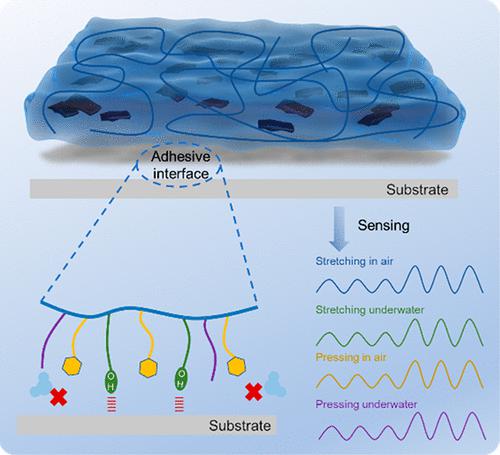当前位置:
X-MOL 学术
›
ACS Appl. Mater. Interfaces
›
论文详情
Our official English website, www.x-mol.net, welcomes your
feedback! (Note: you will need to create a separate account there.)
Bio-Inspired Instant Underwater Adhesive Hydrogel Sensors
ACS Applied Materials & Interfaces ( IF 8.3 ) Pub Date : 2022-09-27 , DOI: 10.1021/acsami.2c13371 Shaoshuai He 1, 2 , Bingyan Guo 2 , Xia Sun 3 , Mingyue Shi 2 , Hong Zhang 2, 4 , Fanglian Yao 2, 4 , Hong Sun 1 , Junjie Li 2, 4
ACS Applied Materials & Interfaces ( IF 8.3 ) Pub Date : 2022-09-27 , DOI: 10.1021/acsami.2c13371 Shaoshuai He 1, 2 , Bingyan Guo 2 , Xia Sun 3 , Mingyue Shi 2 , Hong Zhang 2, 4 , Fanglian Yao 2, 4 , Hong Sun 1 , Junjie Li 2, 4
Affiliation

|
Underwater adhesion plays an essential role in soft electronics for the underwater interface. Although hydrogel-based electronics are of great interest, because of their versatility, water molecules prevent hydrogels from adhering to substrates, thus bottlenecking further applications. Herein, inspired by the barnacle proteins, MXene/PHMP hydrogels with strong repeatable underwater adhesion are developed through the random copolymerization of 2-phenoxyethyl acrylate, 2-methoxyethyl acrylate, and N-(2-hydroxyethyl) acrylamide with the presence of MXene nanosheets. The hydrogels are mechanically tough (elastic modulus of 32 kPa, fracture stress of 0.11 MPa), and 2-phenoxyethyl acrylate (PEA) with aromatic groups endows the hydrogel with nonswelling property and prevents water molecules from invading the adhesive interface, rendering the hydrogels an outstanding adhesive behavior toward various substrates (including glass, iron, polyethylene terephthalate (PET), porcine). Besides, dynamic physical interactions allow for instant and repeatable underwater adhesion. Furthermore, the MXene/PHMP hydrogels exhibit a high conductivity (0.016 S/m), fast responsiveness, and superior sensitivity as a strain sensor (gauge factor = 7.17 at 200%–500% strain) and pressure sensor (0.63 kPa–1 at 0–70 kPa). The underwater applications of bionic hydrogel-based sensors have been demonstrated, such as human motion, pressure sensing, and holding objects. It is anticipated that the instant and repeatable underwater adhesive hydrogel-based sensors extend the underwater applications of hydrogel electronics.
中文翻译:

仿生即时水下粘性水凝胶传感器
水下粘附在水下界面的软电子学中起着至关重要的作用。尽管基于水凝胶的电子产品引起了极大的兴趣,但由于它们的多功能性,水分子会阻止水凝胶粘附在基板上,从而成为进一步应用的瓶颈。在此,受藤壶蛋白的启发,通过丙烯酸 2-苯氧基乙酯、丙烯酸 2-甲氧基乙酯和N的无规共聚,开发了具有强可重复水下粘附力的 MXene/PHMP 水凝胶。-(2-羟乙基)丙烯酰胺,存在 MXene 纳米片。水凝胶具有机械韧性(弹性模量为 32 kPa,断裂应力为 0.11 MPa),具有芳香基团的丙烯酸 2-苯氧基乙酯(PEA)赋予水凝胶不溶胀性并防止水分子侵入粘合剂界面,使水凝胶成为对各种基材(包括玻璃、铁、聚对苯二甲酸乙二醇酯 (PET)、猪)具有出色的粘合性能。此外,动态物理相互作用允许即时和可重复的水下粘附。此外,MXene/PHMP 水凝胶表现出高电导率 (0.016 S/m)、快速响应性以及作为应变传感器(在 200%–500% 应变下的应变系数 = 7.17)和压力传感器(0.63 kPa –1在 0–70 kPa)。已经证明了基于仿生水凝胶的传感器的水下应用,例如人体运动、压力传感和保持物体。预计即时和可重复的水下粘合剂水凝胶传感器将扩展水凝胶电子设备的水下应用。
更新日期:2022-09-27
中文翻译:

仿生即时水下粘性水凝胶传感器
水下粘附在水下界面的软电子学中起着至关重要的作用。尽管基于水凝胶的电子产品引起了极大的兴趣,但由于它们的多功能性,水分子会阻止水凝胶粘附在基板上,从而成为进一步应用的瓶颈。在此,受藤壶蛋白的启发,通过丙烯酸 2-苯氧基乙酯、丙烯酸 2-甲氧基乙酯和N的无规共聚,开发了具有强可重复水下粘附力的 MXene/PHMP 水凝胶。-(2-羟乙基)丙烯酰胺,存在 MXene 纳米片。水凝胶具有机械韧性(弹性模量为 32 kPa,断裂应力为 0.11 MPa),具有芳香基团的丙烯酸 2-苯氧基乙酯(PEA)赋予水凝胶不溶胀性并防止水分子侵入粘合剂界面,使水凝胶成为对各种基材(包括玻璃、铁、聚对苯二甲酸乙二醇酯 (PET)、猪)具有出色的粘合性能。此外,动态物理相互作用允许即时和可重复的水下粘附。此外,MXene/PHMP 水凝胶表现出高电导率 (0.016 S/m)、快速响应性以及作为应变传感器(在 200%–500% 应变下的应变系数 = 7.17)和压力传感器(0.63 kPa –1在 0–70 kPa)。已经证明了基于仿生水凝胶的传感器的水下应用,例如人体运动、压力传感和保持物体。预计即时和可重复的水下粘合剂水凝胶传感器将扩展水凝胶电子设备的水下应用。































 京公网安备 11010802027423号
京公网安备 11010802027423号